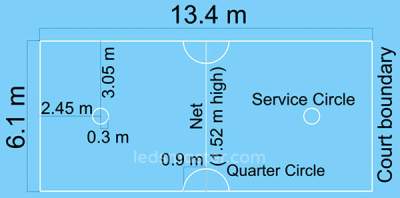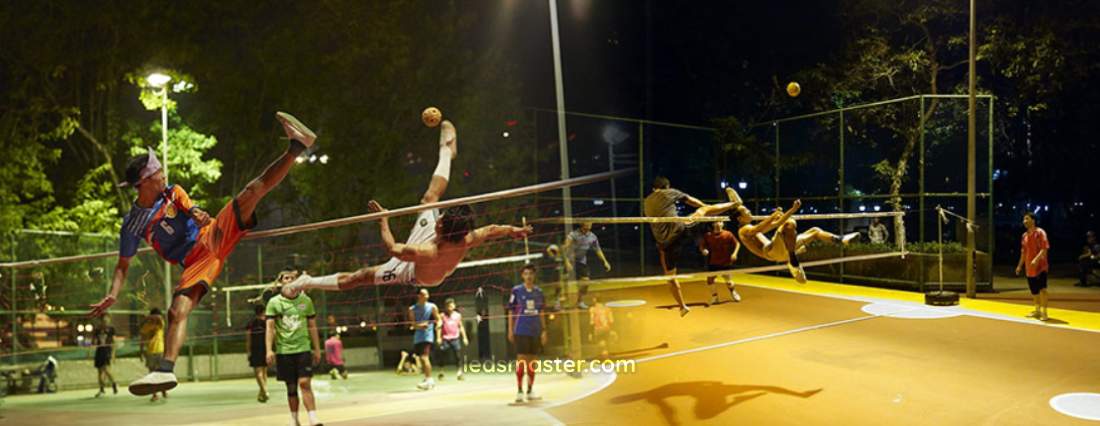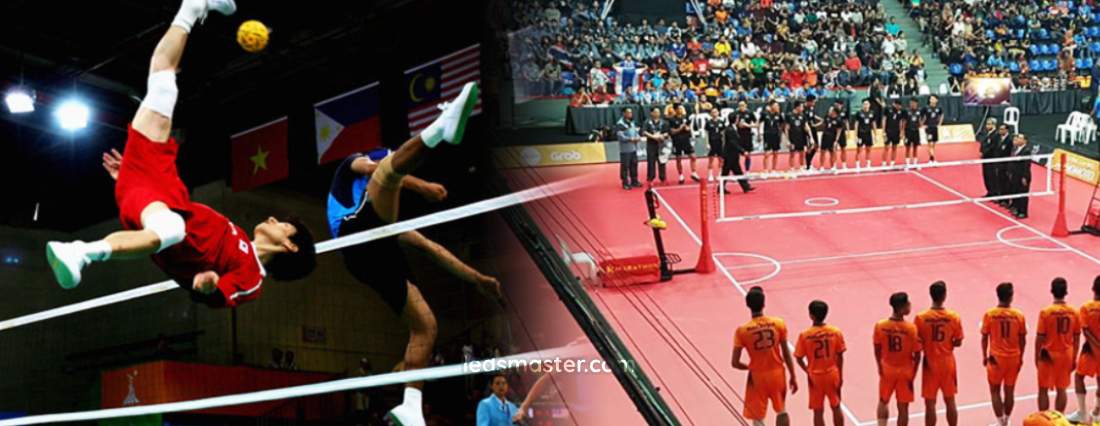Step into the vibrant world of sepak takraw, where agility, precision, and speed converge under the glow of advanced lighting technology. Illuminating these courts isn’t just about brightness—it’s about enhancing the game’s intensity, ensuring every kick and spike is captured with clarity and energy efficiency. Discover why LED lighting is revolutionizing the way we illuminate sepak takraw courts, setting new standards for performance and player experience.
Sepak Takraw originated in Malaysia and has flourished in Southeast Asian countries such as Thailand, Malaysia, Singapore, and Myanmar. To play this sport on outdoor or indoor courts at night, proper LED lighting is essential for a sepak takraw court, often referred to as kick volleyball lights.
This sport blends elements of football and volleyball, as players cannot use their hands to touch the ball and must aim to ground the ball in the opponent’s court. Let’s explore how to illuminate the court for this thrilling sport, whether it’s for new floodlight installations or replacing HPS, halogen, mercury, fluorescent, or metal halide lights.
Get your complimentary lighting design today
Table of Contents
Toggle
The dimensions of a standard kick volleyball court measure 13.4 meters in length and 6.1 meters in width. These measurements inform the lighting requirements, which vary depending on the court’s purpose—whether for recreational use, training, or high-level competitions. For general recreational and community courts, horizontal illumination typically needs to be between 200 and 300 lux, creating adequate lighting for informal games and training sessions. However, when the court is used for professional matches or high-profile events like the Marathon Perses Cup or ASEAN School Games, the illumination requirements rise significantly. Professional kick volleyball matches demand horizontal lighting levels of around 1000 lux to meet the standards for HDTV broadcasts, ensuring that every detail on the court is captured clearly.
To calculate the lighting needs for an international-level court of 13.4 x 6.1 meters, we can multiply the area by the desired lux level, yielding 81,740 lumens. Utilizing LED lighting, which typically operates at an efficiency of 160 lumens per watt, achieving this level of illumination would require approximately 500 watts of LED lighting fixtures. This wattage calculation ensures that the court maintains the correct brightness for competitive games, offering clear visibility for players, officials, and audiences.
Achieving balanced lighting in both horizontal and vertical directions is essential for optimal visibility on a sepak takraw court. Horizontal lighting, which illuminates the court surface, allows players to see the ball, court lines, and each other’s positions with clarity. However, if horizontal lighting is overly bright compared to vertical lighting, it can create visibility issues, as players’ faces might appear dark, obscuring their expressions. This imbalance can make it challenging for cameras to capture clear facial images, detracting from the viewing experience for both on-site audiences and those watching broadcasts.
The recommended ratio between horizontal and vertical illumination should range between 0.75 and 1.5, depending on the type and level of competition. This range ensures that both players and spectators benefit from consistent lighting, enhancing the visual quality of gameplay and facilitating a smoother viewing experience.
Balanced lighting also contributes to audience engagement, as spectators can observe the expressions and reactions of players throughout the match. Well-designed lighting helps capture the intensity of the game, allowing viewers to appreciate the skill and athleticism of the players. Ensuring that both horizontal and vertical brightness are comparable creates a more immersive experience for everyone in attendance.

The color temperature of lighting on a kick volleyball court should ideally fall between 5000K and 6500K. This range offers a bright, daylight-like illumination that enhances players’ visibility and reduces eye strain. A higher color temperature, closer to natural daylight, not only enhances the contrast of the ball and court lines but also provides a more visually comfortable experience for players and officials. This is particularly important for games that extend into the evening or take place indoors, where natural lighting is limited.
Uniform lighting distribution is crucial for a consistent gameplay experience, as it prevents shadows from forming across the court. Shadows or dimly lit areas can hinder players’ ability to anticipate the ball’s movement, affecting performance. For professional courts, a uniformity ratio of at least 0.7 is recommended to ensure even lighting. Uniform lighting enhances not only the gameplay but also the quality of video broadcasts, ensuring that the court appears evenly lit on camera.
Designing an effective lighting system for a sepak takraw court requires expertise in lighting engineering. Consulting with a professional lighting engineer is recommended to achieve the best results, particularly for professional or broadcast-level courts. Engineers can assist in optimizing the position and angle of floodlights, ensuring the correct lux levels are achieved without causing glare or shadows.
Some lighting providers offer free design consultations to help court managers or owners meet required standards. By working with lighting specialists, stadiums can benefit from tailored solutions that optimize both horizontal and vertical lighting, creating a setup suitable for different types of competitions. This level of customization helps achieve ideal illumination levels and ratios, ensuring an exceptional experience for players, officials, and spectators.
LED lighting for sepak takraw courts offers significant energy savings compared to traditional lighting options. By utilizing high-quality Bridgelux LED chips with a luminous efficiency of 140 lm/W, these lights can produce 3 to 5 times higher lumen output than other brands. This means less energy and lower electricity costs to achieve the same brightness. When switching to LED, users will notice a brighter light compared to metal halide, mercury, HPS, or fluorescent lighting. Additionally, LED lights experience lower light attenuation, maintaining their brightness over extended periods of use. This consistent performance over time makes LEDs a cost-effective and reliable lighting solution for sepak takraw courts.
Effective heat dissipation is crucial for indoor sepak takraw court lighting, as excessive heat can damage ceiling fixtures. LEDs are known for their superior heat dissipation capabilities and are often referred to as cool light sources. Unlike traditional lighting, which converts a significant portion of energy into heat, LEDs convert 93 to 97% of energy directly into light. This reduces heat waste and prevents overheating. Our patented design incorporates aluminum fins that increase the surface area for heat dissipation, further enhancing the cooling efficiency. This feature not only protects the light fixtures but also helps maintain a comfortable indoor temperature, improving the overall user experience.

LED lighting boasts an impressive lifespan of up to 120,000 hours, equating to approximately 47 years of use based on 6 to 7 hours of operation per day. In contrast, traditional lighting options such as fluorescent tubes and metal halide floodlights require frequent replacements, often every few months, due to their shorter lifespans. LEDs are more durable and safe to use, as they do not contain brittle glass or delicate components like filaments. They are also impact-resistant, making them ideal for environments where fast-moving sepak takraw balls may occasionally strike the lights. This robustness reduces maintenance costs and enhances safety.
LED lighting is a healthier option compared to traditional lighting systems. Fluorescent tubes contain mercury, and halogen lamps emit UV light, both of which can be harmful to human health. In contrast, LED lights do not contain toxic or volatile chemicals. Additionally, LEDs can be engineered to eliminate UV light by precisely controlling the wavelength within the visible light spectrum. This makes LED lighting a safer choice for both players and spectators, ensuring a healthier environment for all.
LED lighting stands out as the optimal choice for sepak takraw courts, offering superior energy efficiency, enhanced heat dissipation, exceptional durability, and healthier illumination compared to traditional lighting options. By adopting LED technology, courts can achieve significant cost savings, minimize maintenance needs, and create a safer and more comfortable playing environment for athletes and spectators alike.